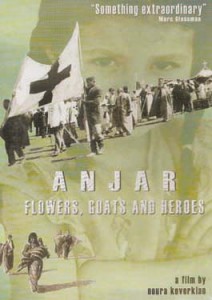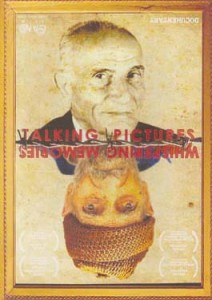Evelyn Demirchian
Staff Writer
 Films showcased at this year’s 11th Annual Armenian Film Festival held Friday, February 26, ranged in form with entries from animated shorts to lengthier documentaries. International directors sent in their works and of the films shown, several struck an emotional chord as they hit at the heart of what the Armenian community will be remembering and recognizing next month with Armenian Genocide Awareness Week in April.
Films showcased at this year’s 11th Annual Armenian Film Festival held Friday, February 26, ranged in form with entries from animated shorts to lengthier documentaries. International directors sent in their works and of the films shown, several struck an emotional chord as they hit at the heart of what the Armenian community will be remembering and recognizing next month with Armenian Genocide Awareness Week in April.
The Film Festival is sponsored by the Armenian Studies Program and Armenian Students Organization at Fresno State, with partial financial support provided by the Diversity Awareness Program of the University Student Union and was held on the Fresno State campus.
Hove (the Wind) by Alex Webb, is a very short film but had serious subject matter. Clocking in at nine minutes, this beautifully shot tale involves two women and their secrets; one an older store owner with a dark book and tragic past, and the other a younger woman recently struck by tragedy.
The younger woman, Nina, lost her child but the audience never finds out why. Nina catches the bookstore owner, Zara, glancing through a book emblazoned with a swastika on the cover. Zara refuses to show Nina the book, fearing that the matter contained within its pages is too painful for Nina to see, due to her recent tragic loss. Zara goes to find a trinket she had been given by a surviving relative of hers from the Armenian Genocide who had lost nearly all her children, and as she comes back Nina leaves, going to look for the Nazi book herself.
What young Nina finds in the book, a gathering of blueprints for the Nazis, ties together Zara’s family history and the special trinket to the book in something larger and darker. It reveals a startling connection between the tragedies experienced by Armenians in 1915 being a direct influence upon the Holocaust some 30 years later.
The technical aspects of the film are also worth noting. The dialogue and soundtrack are kept very minimal; the few words said between the women are enough to express the gravity of their stories. An exceptional storyteller, Webb has received many honors for Hove, including an Honorable Mention for Best Short at the Pomegranate Film Festival in Toronto back in September 2009.
Another film that has gained plenty of attention is Anjar: Flowers, Goats and Heroes, by director and photographer Noura Kevorkian. A stunning portrait of the Armenian village of Anjar in the Bekka Valley of Lebanon, Kevorkian tells her story with recreations of her memory from living in Anjar as a young child in the 1970’s. In 2001, Noura’s mother wrote to her that one of the village elders, Sarik Nene, had passed away, prompting Kevorkian to pay a visit to Anjar.
Mixed with older photos, live reels from her home video camera, and historical documents, Kevorkian’s film takes us along to Anjar, and focuses on her childhood and specifically the summers when her mother would take her to the village elders to listen to their stories, which range from dreams to light-hearted anecdotes. Soon though, the Lebanese Civil War would break out, and many Armenians from Beirut fled to Anjar for safety.
During this time, the stories become darker, and young Noura comes to find out about the elders’ experiences in World War I, the Turkish government’s harsh treatment, and ultimate decision to wipe out the Armenians from their lands. The stories of the Genocide came to light for young Kevorkian, and she comes to find out that the early settlers of Anjar were refugees from Musa Dagh.
Musa Dagh is a heroic story, as the six Armenian villages were destroyed or evacuated by the Turks, but those who survived by escaping to the mountains were able to withstand the Turkish soldiers until French military ships came to their rescue. Placed at first in a refugee camp in Port Said, Egypt, the survivors were sent by the French and Lebanese government to establish their own village in the Bekka Valley.
 A moving tribute to those survivors, Anjar is a well—paced narrative of discovery and appreciation. It has also been showcased in several festivals, including the ARPA International Film Festival in 2009. The film is eighty-four minutes long, and narrated by Kevorkian in English.
A moving tribute to those survivors, Anjar is a well—paced narrative of discovery and appreciation. It has also been showcased in several festivals, including the ARPA International Film Festival in 2009. The film is eighty-four minutes long, and narrated by Kevorkian in English.
Cutting to a lighter film is Dress Story. An animated short, and only five minutes in length, Dress Story is the tale of a He-Dress and She-Dress who are happily married until the He-Dress cheats on his wife with a Waitress. The two adulterous characters then poison the poor She-Dress and toss her into a garbage bin.
The characters don’t have bodies; they are instead 3-D animated outlines of clothing with invisible body forms. It leaves to the imagination what the characters really look like, and it is an amusing new animated form that differs from traditional visuals.
The two remaining documentaries, Talking Pictures by Mehmet Binay, and Komitas Hairig by Baron Maronian, were both short films. Talking Pictures focuses on the aftermath of Mehmet Binay’s main film Whispering Memories, which dealt with Armenian Christians who had converted to Islam and had become “Turkified” after the Genocide. Talking Pictures finds Binay getting an email from a man named Ghazaros Kerjilian, whose father came from the village of Geben, where Whispering Memories was documented. Ghazaros and Mehmet traveled back to Geben with Ghazaros’s niece to meet the people of his father’s hometown. Those who inhabit the village welcomed them warmly, and relayed to their new friends the troubles they have when they reveal their Armenian ancestry to the Turkish citizens they live with. It is easier for them to not recognize their own past, seeing as it brings conflict and creates anxieties among the groups.
A moving portrait of a beautiful old village, Binay creates a lovely visual with all stop motion and pictures. It is Binay who also has Armenian roots in Turkey, so this project is a personal one as well.
Komitas Hairig on the other end focuses its lens on the Armenians in Turkey during the Genocide, and specifically upon Komitas Vardapet, an important figure in Armenian culture, who was a classically trained musician and priest who is hailed today as a martyr. He went mad after witnessing the atrocities of the 1915 Genocide and spent his final years in a clinic in Paris before passing away in 1935.
This documentary contains interviews about Komitas and the history of the treatment of the Armenian priest from Very Rev. Fr. Nareg Berberian and Dr. Richard Hovanissian. The documentary was an interesting historical addition to the Film Festival, with its clear telling of the life of Komitas Hairig.
Overall, the films chosen for this year’s Festival all touched upon similar themes of loss and survival and most of all, hope.
 Hye Sharzhoom Armenian Action
Hye Sharzhoom Armenian Action